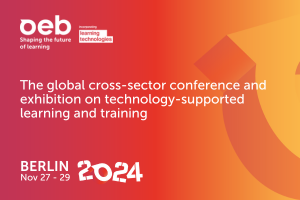Supporting Decision-Making in SMEs
 Namur (BE), November 2007 - AWT, the Wallon Telecommunication Agency has designed an interactive guide of eLearning for small and medium-sized enterprises in Belgium's Walloon region. CHECK.point eLearning spoke with Pascal Balancier, the person in charge of the coordination of eLearning programmes in the Walloon region and designer of the eLearning guide.
Namur (BE), November 2007 - AWT, the Wallon Telecommunication Agency has designed an interactive guide of eLearning for small and medium-sized enterprises in Belgium's Walloon region. CHECK.point eLearning spoke with Pascal Balancier, the person in charge of the coordination of eLearning programmes in the Walloon region and designer of the eLearning guide.
Could you please give us a brief description of the new eLearning guide?
Pascal Balancier: We've produced an online interactive tool for SMEs that supports decision-making and allows managers of small businesses to define their best action plan for eLearning implementation and use. The application is twofold, with an informative part and an interactive one. The former provides all the relevant information about eLearning: concepts and practices, adoption methodology, the pedagogical and technical dimension, and the financial and organisational stake.
Users can explore resources on their own. The interactive part allows the users, through a series of questions (diagnostic tool), to opt for the best adoption scenario in their specific situation and then to build a 'step by step' and coherent action plan to implement the relevant eLearning solution for the business.
It takes less than five minutes to answer the twelve questions of the diagnostic tool. After that, the user receives a double feedback. The first part provides recommendations dedicated to decision-makers and proposes one or several scenarios for the adoption of eLearning.
Various online tools also support the decision-making process: a break-even point calculation tool, immediate access to various online resources like demonstrations, a printable 'report' of the action plan, and so on. The second part of the feedback provides pedagogical advice directed toward eLearning experts, such as the pedagogical methods that best fit the specific context described in the questionnaire, how they can be implemented, etc.
What are the major benefits for the users?
Pascal Balancier: There are a lot of Internet sites dedicated to the promotion of eLearning and providing information and resources about its pedagogical, technical, and organisational aspects, etc. The eLearning guide of the Walloon Telecommunication Agency (AWT) also provides (of course) information and resources, but the real asset of our guide is that it provides a diagnostic tool dedicated to decision taking. The guide has been designed especially for mangers of SMEs, but it can help any decision takers to manage an eLearning project.
The guide itself proposes twelve questions that only require a few minutes to answer. Automatic feedback proposes one or several of the five scenarios identified and developed in the guide. Each scenario is completed with specific information about pedagogical, technical, financial, juridical, and organisational issues.
Each scenario is illustrated by a video showing real examples of enterprises that have developed a similar strategy. By the way, the eLearning guide supports decision taking not in a prescriptive way but in an illustrative way. It feeds and contributes to brainstorming; it helps decision takers to choose an orientation and it provides all relevant information, guaranteeing a successful process.
Could you tell us a bit more about the feedback offered?
Pascal Balancier: As I've mentioned, the feedback is multidimensional. The real originality of the eLearning guide is that it provides a diagnostic tool dedicated to decision making, rather than being one more informative Internet site, even if it also provides a lot of information. Moreover, what is really interesting is the "brightness" imbedded in the diagnostic tool.
The diagnostic tool is based on a relational database, all the elements of which are linked and interdependent. That's why, regarding the answers given for each question in the diagnostic component, the tool provides a specific, automatic, and pedagogically-technically founded piece of feedback.
You are in charge of the coordination of eLearning programmes in the Walloon region. Can you give us an overview of the Walloon eLearning strategy?
Pascal Balancier: Since 2004, eLearning has become a political issue for the government of the Walloon region. Indeed, the PST2 (Strategic and transversal plan II), which focuses on IT issues, has given to the Walloon Telecommunication Agency the responsibility to create a "Cupola of eLearning" in charge of gathering stakeholders and enhancing partnerships and collaboration.
Regarding the financial aspect of this, the cupola receives financial support from the government of the Walloon region and from the European social funds. In regard to the technical and political aspects, the cupola benefits from the expertise of universities and also from advice given by a commission composed of representatives of all stakeholders and end-users.
The cupola of eLearning is not just one more institution focusing on eLearning and competing with existing training institutions. The methodology of the AWT cupola of eLearning is to promote existing solutions, tools, projects, and programmes by bringing help: human and technical resources and also financial support.
The portal Learn-on-Line is a good example. Learn-on-Line provides a catalogue of eLearning courses. The project is carried by five Walloon partners. The eLearning cupola dovetails with the partnership in order to improve and enhance Learn-on-Line projects by providing technical and financial support, rather than developing another portal. Another example is provided by the process induced by the cupola to develop a label to improve the quality of eLearning in the Walloon region and spread good practices.
 2024 neigt sich dem Ende zu und damit starten die Vorbereitungen für das nächste Jahr. Welche Trends werden in 2025 die L&D Branche prägen? Was sind die größten Herausforderungen für Personalentwickler:innen und wie können sie ihnen begegnen? Nehmen Sie sich fünf Minuten Zeit!
2024 neigt sich dem Ende zu und damit starten die Vorbereitungen für das nächste Jahr. Welche Trends werden in 2025 die L&D Branche prägen? Was sind die größten Herausforderungen für Personalentwickler:innen und wie können sie ihnen begegnen? Nehmen Sie sich fünf Minuten Zeit!








